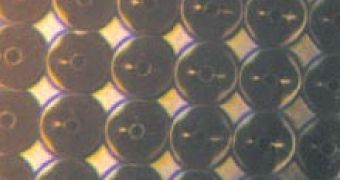Scientists at Microsoft Research published an article in Nature Photonics in which they announce the development of a new pixel design. It consists of a pair of mirrors attached to the pixel, allowing it to work faster, be brighter and more power efficient than today's liquid crystal displays (LCDs). The mirrors would block or transmit light as necessary, and the system is said to be simpler and easier to fabricate than LCDs, meaning that it would also be cheaper.
Half of the global TV market is covered by LCDs today. Also, they represent the most common technology used for cell phone displays and flat-panel computer monitors. There seem to be a few reasons that stop the liquid crystal display from offering the best image quality. The first of them is that the pixels in a LCD do not turn completely off. Besides that, they need an average of about 25 to 40 milliseconds to switch from black to white and otherwise, which creates a blurring effect on fast moving images.
Another very important reason for the lack of performance LCDs come with is the fact that they are almost impossible to use in bright light. "There is nothing in LCD technology that stands out," says Sriram Peruvemba, vice president of marketing at electronic-paper pioneer E Ink, based in Cambridge, MA. "The only reason it has done well is it's the lowest price [flat-panel] display today."
While the LCD displays prove to be faulty in many aspects, the new telescopic pixels have more performance. Firstly, they have the ability of completely turning off, and that in only 1.5 milliseconds. The ultra fast response time means that the color display will be simpler and cheaper, says Michael Sinclair from Microsoft Research.
In order to create a specific color, a pixel in LCDs lights up simultaneously at different intensities three subpixels: red, green and blue. There is also a separate transistor circuit that controls each subpixel, and that translates into a complex circuit. For the telescopic display, red, green and blue light emitting diods can be put behind each pixel and they would be lit up sequentially to create a color shade. Sinclair says that, this way, "complexity and cost of today's LCD" would be reduced.
The novel pixel design is a few times brighter then LCD
Another important feature of the telescopic pixels is the significantly higher brightness they offer. The LCD has only five to ten percent of the light coming out, as it has to pass through the polarizing films, the liquid-crystal layer, and the color filters. With the telescopic pixels, about 36 percent of light would be allowed to come through. "I could get by with a less-powerful backlight, because the telescopic pixel is more efficient," Sinclair says. Having a greater brightness would allow the novel pixel design to be more efficiently used in bright sunlight.
Two micro mirrors are used by the new pixels to block or let the light pass. One is an aluminum disc 100-micrometer-wide and 100-nanometer-thick which has a hole in the center. The other is placed right in front of the hole and has the same dimension. The light is projected from behind the second mirror on the disc shaped one. While the pixel is in the "off" state, both mirrors send the light back to the source. In the "on" state, the light bounces to the second mirror and then comes out through the hole.
The pixels are fabricated by the researchers in a layered fashion, similar to the way silicon chips are manufactured. According to Sinclair, the telescopic design needs fewer layers, which means it is simpler to fabricate than LCDs. The disc shaped mirror is bent by a small voltage applied to an electrode, which is made from indium titanium oxide at this moment, an industry standard. Still, they consider making the electrodes from an extremely thin aluminum layer that would become nearly transparent. The production process would be simplified, and the costs lowered even more.
According to Peruvemba, although the new pixel technology presents advantages over today's LCDs, the mechanical parts are likely to compromise robustness. "There are literally hundreds of thousands to millions of little shutterlike devices that have a mechanical movement," he says. "In most devices, what fails first are the mechanical parts."
Other ideas in the field have also appeared to the surface. While LCD and the new telescopic display have a backlight from which they transmit light, others came up with a display that reflects ambient light. Qualcomm has a new display with MEMS-based pixels set for launch this year on three different cell phones, and has announced a color screen for an MP3 player. E Ink, a black-and-white e-paper displays seller, also announced color and video prototypes.
Compared to LCDs, these displays do not need backlight and constant refreshing. The screen looks even better when more light is around it. "We're not competing with bright ambient light--we're taking advantage of all that sunlight," says Brian Gally, director of engineering at Qualcomm MEMS Technologies. "So it's really analogous to paper."
According to Sinclair, Microsoft Research aims at large, low-cost computer screens. He says that any IT worker dreams of one. There will not be a small screen on which you would have to toggle windows, but a "whiteboard-sized thin screen" to work on.

 14 DAY TRIAL //
14 DAY TRIAL //